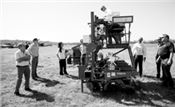|
Monsanto Donates Research Farm Equipment To Arkansas Soybean Breeding Program

Monsanto donated a research planter and bundle thresher to the
Division of Agriculture soybean breeding program.
Division of Agriculture photo by Fred Miller
FAYETTEVILLE, ARK.
Monsanto donated two pieces of research farm equipment to the University of Arkansas System Division of Agriculture soybean breeding program.
The used seed planter and bundle thresher, retired from Monsanto’s fleet of research farm machinery, will upgrade the Arkansas soybean breeding program’s research capabilities, said Leandro Mozzoni, Division of Agriculture soybean breeder.
“The planter allows us to plant breeding seed in shorter rows than our existing equipment,” Mozzoni said. “We will be able to carry out our breeding operations on roughly half as much space as we’ve been using.”
The bundle thresher will allow the breeding team to collect mature seed from nursery plots more quickly and efficiently than current practices, Mozzoni said.
“We are pleased to provide this equipment donation to the University of Arkansas,” said J.D. Rossouw, Monsanto (Monsanto.com) North America and Latin America North Plant Breeding Lead. “Through this donation, we help provide the tools to prepare the next generation of agricultural scientists and leaders by encouraging students to pursue careers in agricultural industries and help drive food security for the future.”
“This equipment will streamline Dr. Mozzoni’s research, which ultimately helps Arkansas farmers,” said Nathan McKinney, assistant director of the Division of Agriculture’s Arkansas Agricutlural Experiment Station.
McKinney said the aim of the soybean breeding program, as with all the division’s crop breeding programs, is to develop improved crop varieties adapted to Arkansas growing conditions. Key improvements sought are higher yields, hardier plants, disease resistance and higher quality food and fiber.
“Arkansas growers will reap the benefits of this generous gift from Monsanto,” McKinney said.
“It was gratifying to be part of this initiative,” said Vivek Sharma, Monsanto cotton breeder who attended the presentation of the equipment. “As an employee of Monsanto, I know that giving back to our communities also extends to these kinds of public and private partnerships. Together we can speed up innovation and pass it along to farmers.”
Mozzoni said the planter automates sowing of breeder seed, a task being done by hand on existing research planters. As a result, plots can be shortened and planted faster. “It’s a significant increase in efficiency,” he said.
“It cuts the space we need nearly in half,” Mozzoni said, “freeing up space for other important research projects.
The bundle thresher will save time, allowing harvested seed to be separated from pods right in the field. Up to now, that process required the pods to be brought back to the breeding lab for separation.
After training the soybean breeding team on use of the equipment, it will be moved to the soybean breeding site at the Rice Research and Extension Center in Stuttgart, Mozzoni said. ∆
|
|